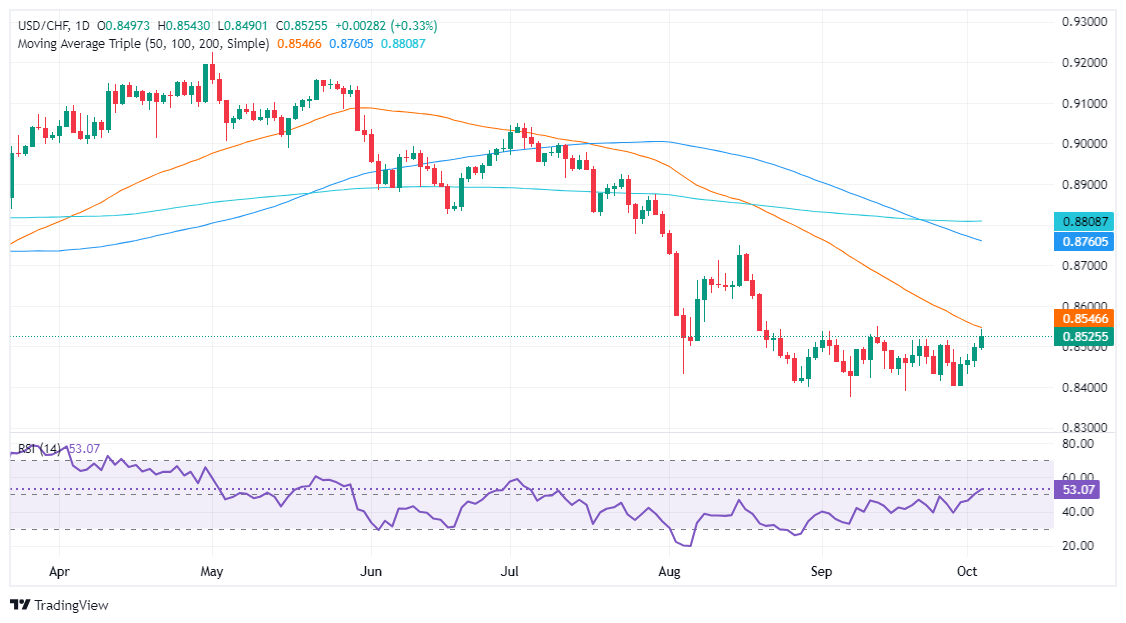USD/CHF Price Forecast: Rises and tests the 50-DMA above 0.8500
- USD/CHF consolidates between 0.8400-0.8550, with bullish momentum suggesting potential for higher prices.
- Buyers need to clear the 50-DMA at 0.8537 and the September 12 peak of 0.8550 to target 0.8600 and 0.8748.
- A downside break below 0.8500 could see a retreat toward 0.8400, where buyers may look for a bounce back to 50-DMA levels.
The USD/CHF posted solid gains of over 0.30% on Thursday as the Greenback recovers some ground, aimed to finish the week with solid gains. As the Friday’s Asian session begins, the pair trades at 0.8522, virtually unchanged.
USD/CHF Price Forecast: Technical outlook
The USD/CHF is neutral to upward biased, after consolidating within the 0.8400-0.8550 area during September and the first four days of October.
Momentum favors buyers as the Relative Strength Index (RSI) turned bullish, hinting that higher prifces lie ahead.
However, USD/CHF buyers need to clear the 50-day moving average (DMA) at 0.8537. If surpassed, the immediate ceiling level to be broken will be the September 12 peak at 0.8550. A breach of the latter will expose the 0.8600 figure, followed by the next cycle high seen at 0.8748. the August 15 high.
On the other hand, if sellers drag prices below 0.8500, the pair could aim toward 0.8400, looking for a bounce, that could push prices to the 50-DMA.
USD/CHF Price Action – Daily Chart

Swiss Franc FAQs
The Swiss Franc (CHF) is Switzerland’s official currency. It is among the top ten most traded currencies globally, reaching volumes that well exceed the size of the Swiss economy. Its value is determined by the broad market sentiment, the country’s economic health or action taken by the Swiss National Bank (SNB), among other factors. Between 2011 and 2015, the Swiss Franc was pegged to the Euro (EUR). The peg was abruptly removed, resulting in a more than 20% increase in the Franc’s value, causing a turmoil in markets. Even though the peg isn’t in force anymore, CHF fortunes tend to be highly correlated with the Euro ones due to the high dependency of the Swiss economy on the neighboring Eurozone.
The Swiss Franc (CHF) is considered a safe-haven asset, or a currency that investors tend to buy in times of market stress. This is due to the perceived status of Switzerland in the world: a stable economy, a strong export sector, big central bank reserves or a longstanding political stance towards neutrality in global conflicts make the country’s currency a good choice for investors fleeing from risks. Turbulent times are likely to strengthen CHF value against other currencies that are seen as more risky to invest in.
The Swiss National Bank (SNB) meets four times a year – once every quarter, less than other major central banks – to decide on monetary policy. The bank aims for an annual inflation rate of less than 2%. When inflation is above target or forecasted to be above target in the foreseeable future, the bank will attempt to tame price growth by raising its policy rate. Higher interest rates are generally positive for the Swiss Franc (CHF) as they lead to higher yields, making the country a more attractive place for investors. On the contrary, lower interest rates tend to weaken CHF.
Macroeconomic data releases in Switzerland are key to assessing the state of the economy and can impact the Swiss Franc’s (CHF) valuation. The Swiss economy is broadly stable, but any sudden change in economic growth, inflation, current account or the central bank’s currency reserves have the potential to trigger moves in CHF. Generally, high economic growth, low unemployment and high confidence are good for CHF. Conversely, if economic data points to weakening momentum, CHF is likely to depreciate.
As a small and open economy, Switzerland is heavily dependent on the health of the neighboring Eurozone economies. The broader European Union is Switzerland’s main economic partner and a key political ally, so macroeconomic and monetary policy stability in the Eurozone is essential for Switzerland and, thus, for the Swiss Franc (CHF). With such dependency, some models suggest that the correlation between the fortunes of the Euro (EUR) and the CHF is more than 90%, or close to perfect.

